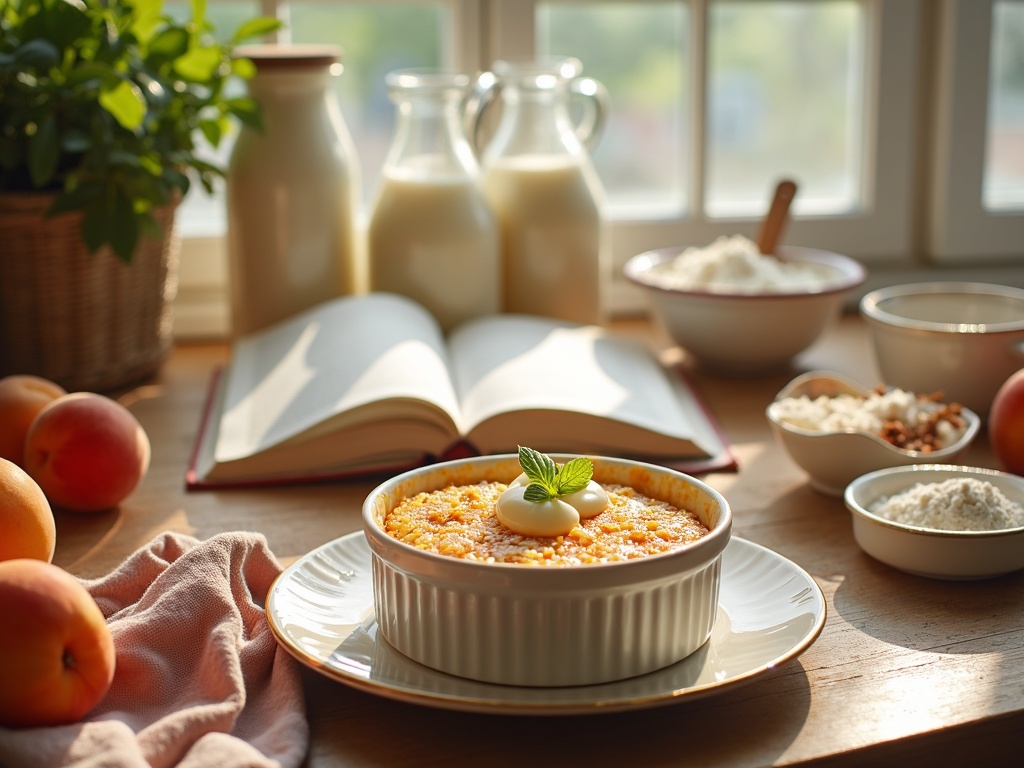Malva pudding, a cherished South African dessert, traces its origins to Dutch settlers and showcases the perfect fusion of European techniques with local ingredients through its distinctive cakey-yet-gooey texture. This warm, comforting treat has grown from its humble beginnings to become a cultural institution, appearing at everything from Sunday family gatherings to weddings and crossing all cultural divides in South Africa.
Find In This Article
Key Takeaways
- The traditional recipe features apricot jam in the batter, giving the pudding its subtle fruity undertones and distinctive sweetness.
- What makes malva pudding special is the hot syrup treatment—a rich blend of cream, butter, and sugar that transforms the cake as it absorbs into every pore.
- While simple to make with basic ingredients, the specific preparation sequence and baking time are crucial for achieving the perfect texture.
- The dessert is traditionally served warm with cold accompaniments like vanilla ice cream, custard, or whipped cream for a delightful temperature contrast.
- Creative variations include chocolate malva pudding, coconut versions, and spiced adaptations with cinnamon, nutmeg, and cardamom.
The Sweet History Behind South Africa’s Beloved Dessert
Malva pudding holds a special place in South African culinary heritage, tracing its origins back to the Dutch settlers who arrived at the Cape in the 17th century. This warm, comforting dessert perfectly captures the fusion of European techniques with local African ingredients, creating something truly unique to South African cuisine.
I’ve found that what makes malva pudding so distinctive is its delightful pudding texture that strikes the perfect balance between cakey and gooey. The batter creates a soft, spongy cake that’s drenched in a sweet, buttery sauce while still warm, allowing the sauce to soak into every fiber of the dessert. This gives it that characteristic moist texture that melts in your mouth with each bite.
Cultural Significance and Celebrations
Malva pudding isn’t just a dessert—it’s a cultural institution in South Africa. You’ll find this sweet treat at virtually every important gathering across the country. The dessert has become synonymous with:
- Sunday family lunches where generations gather around the table
- Holiday celebrations, particularly during winter when its warmth is most appreciated
- Traditional braais (South African barbecues) where it serves as the perfect sweet finale
- Christmas dinners, where it often appears alongside other traditional South African desserts
- Weddings and special occasions, representing sweetness and prosperity
What fascinates me about malva pudding is how it crosses cultural and racial divides in a country with a complex history. It’s enjoyed equally in different communities across South Africa, making it a true unifier at the dinner table.
Flavor Evolution Through History
The name “malva” has sparked debate among food historians. Some believe it comes from “Malvasia,” a sweet wine from the Mediterranean that was possibly used in early versions. Others suggest it relates to the Afrikaans word “malvalekker,” referring to marshmallow, which hints at its soft texture.
Over generations, the recipe has evolved while maintaining its core identity. The traditional version features a light apricot jam in the batter, giving it a subtle fruity undertone. The modern interpretation often includes variations with sticky toffee elements or chocolate infusions, though purists might argue these stray from the authentic experience.
The sauce is where the magic truly happens. A rich blend of cream, butter, sugar, and sometimes a touch of vanilla creates the signature syrup that transforms the cake. In some South African homes, the recipe has been passed down through generations, with each family adding their own special twist to the basic formula.
I’ve noticed that restaurants across South Africa often compete to create the most authentic or innovative version of malva pudding. From high-end establishments in Cape Town to rural farm kitchens in the Karoo, this dessert maintains its position as a beloved national treasure.
The global spread of South African cuisine has taken malva pudding beyond the country’s borders, with international chefs discovering its appeal. Yet nothing compares to enjoying it in its homeland, preferably after a hearty meal, where it serves as both dessert and a comforting bread pudding alternative that speaks to the soul of South African hospitality.
This humble dessert stands as a sweet testament to South Africa’s complex cultural tapestry—European techniques blended with African warmth and hospitality, creating something that transcends its simple ingredients to become a national icon.
How to Make This Decadent Pudding
Malva pudding is one of those desserts that looks impressive but doesn’t require professional baking skills. I’ve perfected this recipe over many attempts, and I’m excited to share the exact process that delivers that signature sticky, moist texture every time.
Essential Ingredients and Preparation
The magic of South African desserts like malva pudding lies in simple ingredients working together beautifully. For the pudding batter, you’ll need:
- 1 cup all-purpose flour
- 1 cup granulated sugar
- 2 large eggs at room temperature
- 1 tablespoon smooth apricot jam
- 1 teaspoon baking soda
- 1/3 cup milk
- 1 tablespoon white vinegar
- 2 tablespoons butter, melted
The irresistible sauce that transforms this cake into a pudding requires:
- 1 cup heavy cream
- 1/2 cup sugar
- 1/4 cup butter
- 1 teaspoon pure vanilla extract
To start the batter, I preheat my oven to 350°F (180°C) and grease a 9-inch square baking dish. Mixing the batter follows a specific sequence for best results. First, I beat the sugar and eggs until pale and fluffy—this takes about 3-4 minutes with an electric mixer. The light, airy texture at this stage helps create that perfect final consistency.
Next, I fold in the apricot jam, which adds subtle fruity notes that distinguish traditional pudding desserts from ordinary cakes. In a separate small bowl, I combine the milk and vinegar, allowing it to stand for about a minute. This creates a quick buttermilk substitute that activates the baking soda.
I then sift together the flour and baking soda before folding them gently into the egg mixture. The melted butter and milk mixture go in last, incorporated with minimal mixing to maintain airiness. Over-mixing at this stage can make the pudding dense rather than light.
The batter should be poured into the prepared baking dish and baked for exactly 25 minutes. The ideal doneness is when the top is golden brown and a toothpick inserted comes out mostly clean but with a few moist crumbs. Don’t wait until the toothpick comes out completely clean—this would result in an overdone pudding.
While the cake bakes, I prepare the sauce by combining all sauce ingredients in a small saucepan over medium heat. The mixture should be brought just to a simmer, stirring occasionally until the sugar dissolves completely. This takes about 3-4 minutes—no longer, as you don’t want to reduce the sauce.
The critical moment comes when the cake emerges from the oven. While still hot, I poke small holes all over the surface with a skewer or fork. Then I pour about two-thirds of the hot sauce evenly over the entire surface. The cake will seem to be floating in sauce, but this is exactly what creates pudding perfection.
After allowing it to absorb for 10 minutes, I pour the remaining sauce over the top. The pudding should rest for at least 20 minutes before serving, which allows the sauce to thoroughly penetrate the cake.
For the most authentic experience, I serve malva pudding warm with a scoop of vanilla ice cream or a splash of cold custard. The temperature contrast between the warm, sticky pudding and cold accompaniment creates a delightful sensory experience that elevates this humble dessert to something truly special.
The finished pudding keeps well in the refrigerator for up to three days and can be reheated in the microwave for 20-30 seconds before serving.
What Makes It Uniquely Special
Malva pudding stands out in the dessert world thanks to its irresistible combination of flavors and textures that create a truly memorable eating experience. I’ve found that understanding these special elements helps appreciate this South African treat even more.
Distinctive Ingredients and Preparation
The signature apricot jam folded into the batter gives malva pudding its characteristic sweetness and subtle fruity undertone that you won’t find in other traditional desserts. This isn’t just any sponge cake – it’s a carefully crafted creation where each ingredient plays a crucial role. The unique combination of vinegar and milk creates a chemical reaction that results in an exceptionally tender crumb structure. This technique breaks down proteins in the flour, yielding a pudding that’s both light and substantial.
What truly sets malva pudding apart from other desserts is the hot syrup treatment. Once baked, the warm cake gets drenched with a rich, buttery syrup that slowly absorbs into every pore. This creates that signature moisture-rich texture that melts in your mouth with each bite. The syrup contains cream, butter, sugar, and vanilla – transforming a simple sponge into something extraordinary as it soaks through.
Cultural Significance and Serving Style
In South African culture, malva pudding holds a special place as a traditional braai (barbecue) dessert. I’ve discovered that serving it warm is essential to experiencing its full character. The heat activates the rich flavors and ensures the syrup-soaked texture is at its prime. Many South Africans enhance the experience by pairing it with custard or ice cream, creating a delightful temperature contrast.
The dessert’s rich flavor profile makes it perfect for cool evenings, where the warm, sweet notes of caramelized sugar and apricot provide comfort and satisfaction. Unlike its British sticky toffee pudding cousin, malva pudding has a distinct caramelized exterior that gives way to an incredibly moist interior – a textural journey that’s uniquely its own.
The magic of malva pudding lies in these carefully balanced contrasts – sweet yet complex, moist yet structured, simple yet sophisticated. Each bite delivers warmth, sweetness, and that unmistakable South African character that has helped this humble dessert gain fans worldwide.
Creative Ways to Serve It
Malva pudding’s rich, sticky sweetness makes it the perfect canvas for creative serving ideas. I’ve found that the right accompaniment can transform this beloved South African dessert from simply delicious to absolutely unforgettable. The key is finding the perfect balance that complements rather than overwhelms its distinctive apricot-caramel notes.
Classic Pairings That Never Disappoint
The traditional approach to serving malva pudding involves adding a creamy element that creates a wonderful contrast with the warm, spongy texture. These classic options never fail to impress:
- Vanilla custard: A silky pouring custard creates a luxurious puddle around the warm cake
- Freshly whipped cream: The lightness cuts through the pudding’s richness perfectly
- Vanilla ice cream: The temperature contrast between hot pudding and cold ice cream creates a sensational taste experience
- Crème fraîche: For a slightly tangy alternative that balances the sweetness
I’ve discovered that warm, sticky desserts like malva pudding benefit tremendously from these cool, creamy accompaniments. The contrast in temperatures and textures creates a multi-dimensional experience that highlights the pudding’s caramelized edges and moist interior.
Elevating with Fresh Elements and Presentation
To take your malva pudding presentation to the next level, I recommend introducing fresh elements and paying attention to visual appeal:
Fresh fruit brings color and a welcome brightness that balances the dessert’s richness. Berries work exceptionally well – try raspberries, blueberries or sliced strawberries. For a more seasonal approach, fresh peach slices or poached pears offer delightful alternatives.
The magic often happens in the temperature play between components. The contrast of warm pudding against cold toppings creates that perfect moment when ice cream just begins to melt, creating a sauce that mingles with the pudding’s syrupy coating.
For presentation that wows dinner guests, try these approaches:
- Individual ramekins allow for perfect portion control and elegant plating
- Dust with powdered sugar just before serving for a simple yet effective finishing touch
- Use warmed plates to keep the pudding at optimal temperature throughout the eating experience
- Create height by stacking a scoop of ice cream atop the pudding rather than alongside it
- Garnish with mint leaves or edible flowers for a pop of color
For an unexpected twist, consider serving smaller portions of malva pudding alongside other complementary desserts for a tasting plate that allows guests to sample various sweet treats.
The rustic charm of malva pudding also lends itself beautifully to family-style serving. I find that bringing a large dish to the table with various toppings allows everyone to customize their portion according to taste preferences.
For special occasions, try preparing individual portions in glass serving dishes to showcase the beautiful layers – pudding on the bottom, a drizzle of cream, fresh fruit, and perhaps a sprinkle of toasted almonds for crunch. This layered pudding approach creates visual interest and ensures each bite contains a perfect balance of flavors and textures.
Whether you’re serving malva pudding for a casual family dinner or an elegant dinner party, these creative serving ideas will help you present this beloved dessert in its most flattering light, ensuring every spoonful delivers maximum pleasure.
Delicious Variations to Try
I’ve discovered that experimenting with malva pudding opens up a world of flavor possibilities. The classic version is just the beginning – with a few creative twists, you can transform this beloved South African dessert into something even more extraordinary.
Sweet and Spicy Adaptations
Adding chocolate to malva pudding creates a decadent treat that’s perfect for serious dessert lovers. I simply mix 2-3 tablespoons of unsweetened cocoa powder into the batter for a rich chocolate version that pairs beautifully with the traditional apricot sauce. For an extra indulgent touch, I sometimes fold in dark chocolate chips that melt into pockets of gooey goodness throughout the pudding.
Coconut malva pudding offers a tropical twist that’s absolutely divine. I incorporate about ¼ cup of desiccated coconut into the batter and sometimes substitute a portion of the milk with coconut milk. This variation adds a subtle nutty flavor and slightly chewy texture that complements the sticky sweet sauce perfectly.
For those who love warming spices, a spiced malva pudding might become your new favorite. I enhance the batter with:
- 1 teaspoon ground cinnamon
- ½ teaspoon freshly grated nutmeg
- ¼ teaspoon ground cardamom (optional)
- A pinch of ground cloves
These spices create a wonderfully aromatic pudding that’s especially comforting during colder months. The spiced variation pairs exceptionally well with other traditional desserts on a holiday table.
Regional adaptations of malva pudding reflect local tastes and available ingredients. In coastal areas of South Africa, I’ve tasted versions that incorporate a hint of citrus zest. Some families add finely chopped dried apricots to the batter, creating a direct connection to the apricot jam that’s traditionally used. In the Western Cape, I’ve encountered variations that include a splash of local brandy in the sauce for an adult twist.
For a refreshing summer version, I sometimes serve malva pudding with fresh berry compote instead of the traditional sauce. The tartness of the berries cuts through the sweetness, creating a beautiful balance.
No matter which variation you try, the key to a successful malva pudding remains the same – don’t overbake it! The center should remain moist and pudding-like, ready to absorb all that delicious sauce.
Know Before You Indulge
When baking a delicious malva pudding, I always find it helpful to understand the nutritional content. This South African dessert is undeniably delightful but comes with its share of calories and sugar that I need to keep in mind.
Nutritional Breakdown
A standard 100g serving of malva pudding contains approximately 350 calories. This sweet treat packs about 18g of fat and 45g of carbohydrates, with around 10g coming from sugar. These numbers make sense considering the traditional ingredients like butter, sugar, eggs, and the sweet apricot sauce that gives this pudding its characteristic moisture and flavor.
If you’re watching your calorie intake but still want to enjoy this delicious classic dessert, portion control becomes your best friend. I’ve found that serving malva pudding in smaller ramekins rather than cutting large slices helps manage portion sizes more effectively. Another trick is to share a serving with someone else – you still get the experience without all the calories.
Healthier Adaptations
I’ve experimented with several ways to make malva pudding a bit more nutritionally balanced:
- Reduce the sugar content by 25-30% without drastically affecting the taste
- Substitute half the white flour with whole wheat flour for added fiber
- Use low-fat milk instead of full-fat versions
- Try coconut sugar as an alternative to white sugar for a lower glycemic index
- Add grated apple to the batter for natural sweetness and moisture
For the sauce, which traditionally contains butter and sugar, I’ve had success using Greek yogurt mixed with a small amount of honey for a protein-rich alternative that still provides creaminess. This change alone can reduce the calorie content by about 15%.
If you’re following a specific dietary plan, consider making a nutritious pudding alternative that captures some of the warm, comforting elements of malva pudding without all the sugar and fat.
While these modifications might not produce an authentic malva pudding, they create a dessert inspired by the original that’s more aligned with modern nutritional awareness. I’ve served these adapted versions to guests without announcing the changes, and they’ve been very well received.

Sources:
South African Food Blog – “Malva Pudding: A South African Classic”
Culinary Heritage Journal – “The History of Malva Pudding”
Healthily Eating Magazine – “Nutritional Breakdown of Malva Pudding”

